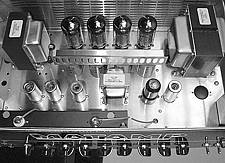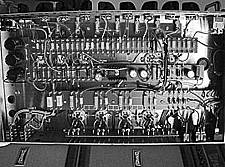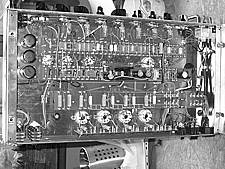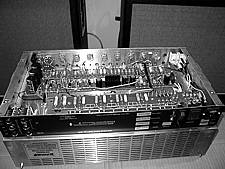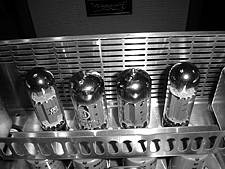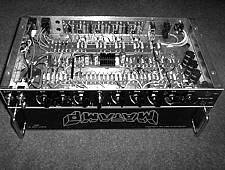Matamp History
Posted on Februar 7, 2008
Filed Under History | Kommentare deaktiviert für Matamp History
The UK has gained ground in the custom amplifier market over the past few years, but America is still king – or so we thought. With many boutique amps coming from the USA, it may come as a surprise to learn that the home of one of America’s most revered amp builders isn’t in a sunny Californian suburb, but a converted mill in the village of Meltham, West Yorkshire,England, set in some of the most stunning countryside the UK has to offer. This is the home of Matamp – one of our oldest marques and yet one of the least well known.
The Matamp story goes all the way back to the beginning of rock’n’roll: Mat Mathias was a German Jew who was evacuated to the UK as a child during WWII – his first job was as a cinema projectionist and it was probably this which inspired his interest in electronics. With a post-war grant from the German government Mat started his own company, initially working from a garden shed, with the self-taught ability to fix almost anything electronic quickly earning him the nickname ‚The Radio Doctor‘. Continued success led to Radiocraft (Huddersfield) moving to larger premises in King Street and becoming a limited company in 1958. Mat’s love of music also led him to build a recording studio used by many local artists and groups: with almost every contemporary guitarist using Vox amplification, a search for alternative sounds prompted Mat to design his own circuit, and in 1963 after many one-off prototypes the first production model was the Matamp Series 2000 – an amplifier with its own special place in British popular music history, and arguably just as significant as Marshall’s 1962 ‚Blues breaker‘ or Vox’s AC30. Why? Well, the next time you hear a recording of ‚Albatross‘ (the haunting instrumental which took Peter Green’s Fleetwood Mac to No 1 in the charts and world fame in 1969), listen carefully – the guitar is that famous sunburst Les Paul standard, and the amp making it sound so rich and warm is a Series 2000, used with a Matamp ‚piggyback‘ valve reverb unit.
In the late sixties, a mutual contact introduced Mat to Clifford Cooper who owned a music shop called ‚Orange‘ in London’s Old Compton Road and the two went into partnership, with Cooper distributing Matamp in the south of England. First in black and later in bright orange vinyl, the Matamp was instantly recognisable and its rich sound and rugged durability ensured a rapid rise in popularity. The 20-watt Series 2000 was a key element of Peter Green’s tone on many early recordings, however when Fleetwood Mac embarked on their first USA tour a more powerful design was needed to cope with the venues they were booked into. With little advance notice Mat designed and built several 100 watt heads using two KT88 power valves and two valve rectifiers, and travelled with Fleetwood Mac, to be on hand if any of his amps needed attention. The tour was a huge success – Matamp soon changed from aluminium to steel chassis to meet increased demand, and later the output doubled again to 200 watts using four KT88’s and solid-state rectifiers. Jimmy Page used one of these legendary Matamp 200 watt heads, while Matamp’s pro audio reputation was ensured when the BBC ordered several of the slave versions to power the Radio 1 road show. By now, everyone who could afford one was using a Matamp – at one point, they reportedly even outsold Marshall two to one. With a healthy order book and many bands (from dual-lead harmonists Wishbone Ash to the Osmond’s) relying on the distinctive Matamp tone, not to mention pubs and clubs throughout the country ordering their disco and PA equipment, the future looked bright – however a series of disagreements ended with the dissolution of the Cooper-Mathias partnership. Mat returned to using the Matamp brand, while Cooper continued producing backline renamed as ‚Orange -Voice of the World‘. From such a promising start, the next few years saw a decline – with his health failing, Mathias sadly died in 1989 and left the company to his sons, who eventually decided to concentrate on other business interests and passed the baton over to Jeff Lewis – a long-time associate of Mat’s.
Today, Matamp’s custom business is global, the brand’s heritage continues to inspire a devotion bordering on the fanatical – used amps are rare, often changing hands for far more than the original price. Part of the long journey back has been a total reorganisation of the amp range: Matamp’s new custom service lets customers choose from a range of preamps, output stages and head/combo cabinets, all assembled and tweaked to perfection by a small but highly experienced team of artisans. From classic hi-fi low gain to ultra-modern high gain, there’s a sound and feature for every player, and a cabinet style for every taste. We were tempted enough to put in an order of our own, and took the opportunity to see the amp and cab assembled for us over a weekend – something that any Matamp customer can do.
Walking through the concealed entrance into Matamp’s converted mill workshop is like taking a trip back into the past – there’s no reception area, and you’re immediately surrounded by the sights, sounds and smells of a small but very busy manufacturing operation which is probably not much different from how it was thirty years ago. The workshop covers three floors: cabinets are cut and fabricated on the ground floor, the electronics assembly and covering takes place on the first floor, and above this is an office and a small audition room. Everywhere you look there’s a wealth of memorabilia and gadgets that anyone with a passing interest in audio electronics would happily sell a relative for. A picture of Mat with Mick Fleetwood takes pride of place in the office, which is also home to the Matamp Registry – a detailed archive stretching back nearly fifty years, with chassis numbers and test measurements for every item that Matamp have sold. Against some entries, customer details like ‚Wishbone Ash‘, ‚Emperor Rosko‘ or ‚BBC‘ are added in Matt’s own handwriting.
Despite the busy work environment with a telephone almost constantly ringing, the welcome is warm and the atmosphere very relaxed. Once you’re in and settled with a mug of coffee, the first thing to do is decide on the circuit – there’s a wide range of single or dual channel preamps (some including reverb and/or tremelo), and an equally wide range of power stages from 20 to 120 watts. You make your initial choice by playing through one of two dozen or so ‚factory masters‘, which are held on a rack in the electronics workshop, ready for immediate audition. Following this, you can talk over any modifications you might need – altering tone or gain controls to suit personal taste is all part of the service. Then work starts on assembling the chassis and circuitry – the internals are point-to-point hand wired on special patent-applied-for turret boards, which have PCB tracks in the base. “ It’s a system that gives us the consistency of PCB construction with the reliability of point-to-point“ said Dave Green, Matamp’s design engineer: “ We’ve repaired many old Hiwatts, and noticed the small link wires underneath their conventional turret boards were often broken. Changing the wires to PCB tracks prevents that, and makes assembly much simpler.“ Several boards go into a welded stainless steel chassis – the components and construction standard are absolutely top-notch, and owe much to Matamp’s hi-fi heritage. While the chassis is being assembled and tested, it’s time to consider the woodwork: there’s a wide range of combo and head/cabinet designs and a bewildering assortment of vinyl and speaker cloth.
Cabinets are made from top-grade birch ply: „We use a CNC machine for production runs“ explained Jeff, “ but for one-offs it’s quicker to make by hand – we have jigs for just about any cabinet you can think of.“ Again, the craftsmanship is top-notch – as the various pieces that make a cabinet come together, the joints are absolutely perfect. Once the carcass is assembled, the chamfered softwood pieces that give traditional Matamp cabs their unique look are cut, mitred and nailed into place, followed by supports for backs and speaker baffles. Corners are radiused and slots are cut for the decorative stringing and then the completed cabinet is sanded smooth and inspected prior to being taken upstairs for covering. Watching this done by hand is fascinating – Matamp cabs have a lot of detail work that makes for a real challenge to cover neatly. „Everyone has their own method for covering“ explained Jeff „There’s no right or wrong way – you just find one that works best for you. We have a glueing machine for production work, but we do one-offs by hand as it takes ages to prime the machine and clean it afterwards.“ The fabric is cut to size on a long table, and then a special formula EVA glue is applied with a roller. The cabinet is placed on top and the material is laid over it one side at a time – a blunt scraper tool is used to remove air bubbles, and also acts as a straight edge for cutting in corners. A hot-air gun controls the adhesive, letting the craftsman speed up or slow down the setting time – this is vital for achieving sharp edges on corners. With the vinyl applied, the cab gets another inspection before the stringing is fitted. This purely decorative item is pushed into a groove machined into the cabinet – in all; it takes about forty minutes to cover a 4×12. With the grille cloth stapled into place the baffle is fitted, followed by corners and handles – then the loudspeakers are bolted in and wired up. Again Matamp offer a choice of driver, and several sample cabs to play through.
Finally, amp and cab meet for the first time and the customer can plug in to see if it comes up to expectation – final tone tweaks are made, and then everyone gets to stand back and admire the finished product. „We try to get the amp absolutely right before it leaves us“ said Dave “ Occasionally a customer will call us a few weeks later and ask for a minor change – it’s no problem for us to do that, and we’ll rework it until it’s exactly what the customer wants.“ Buying a Matamp is totally different from buying any other amplifier, and we enjoyed the experience immensely – John Firth, Mat’s right-hand man in the glory years and now Matamp’s archivist summed it up: „If there’s one reason for this little company surviving against the odds for over fifty years, then it has to be because Matamp started as a group of friends who loved music and electronics and supported every customer 110 per cent. That’s just as true today as it always was“

